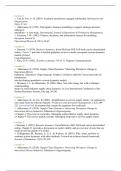Summary
Summary All Data-Driven Design articles
- Course
- Institution
Since DDDA was my last course to finish my MSc of Supply Chain Management I took no risk and carefully summarised all the articles. Overall the exam is partly about making a model. However, a big part is also knowing all the articles. By knowing all the articles by heart and doing a bit of modellin...
[Show more]



